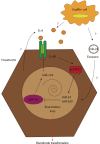MicroRNA-feedback loop as a key modulator of liver tumorigenesis and inflammation
- PMID: 23382622
- PMCID: PMC3558567
- DOI: 10.3748/wjg.v19.i4.440
MicroRNA-feedback loop as a key modulator of liver tumorigenesis and inflammation
Abstract
A recent work of Iliopoulos et al published in Cell highlighted a circuit orchestrated by microRNAs (miRNAs) that results in liver tumorigenesis and inflammation. This feedback loop, governed by miR-24 and miR-629, promotes a hepatocyte nuclear factor-4α transient inhibition resulting in miR-124 induction and signal transducer and activator of transcription 3 activation. These promising data support the use of miRNA mimics or inhibitors as potent therapeutic approaches in liver cancer.
Keywords: Hepatocellular oncogenesis; Hepatocyte nuclear factor-4α; Interleukin-6; MicroRNA; Signal transducer and activator of transcription 3.
Figures

References
-
- Sladek R, Giguère V. Orphan nuclear receptors: an emerging family of metabolic regulators. Adv Pharmacol. 2000;47:23–87. - PubMed
-
- Stegmann A, Hansen M, Wang Y, Larsen JB, Lund LR, Ritié L, Nicholson JK, Quistorff B, Simon-Assmann P, Troelsen JT, et al. Metabolome, transcriptome, and bioinformatic cis-element analyses point to HNF-4 as a central regulator of gene expression during enterocyte differentiation. Physiol Genomics. 2006;27:141–155. - PubMed
MeSH terms
Substances
LinkOut - more resources
Full Text Sources
Other Literature Sources
Medical

